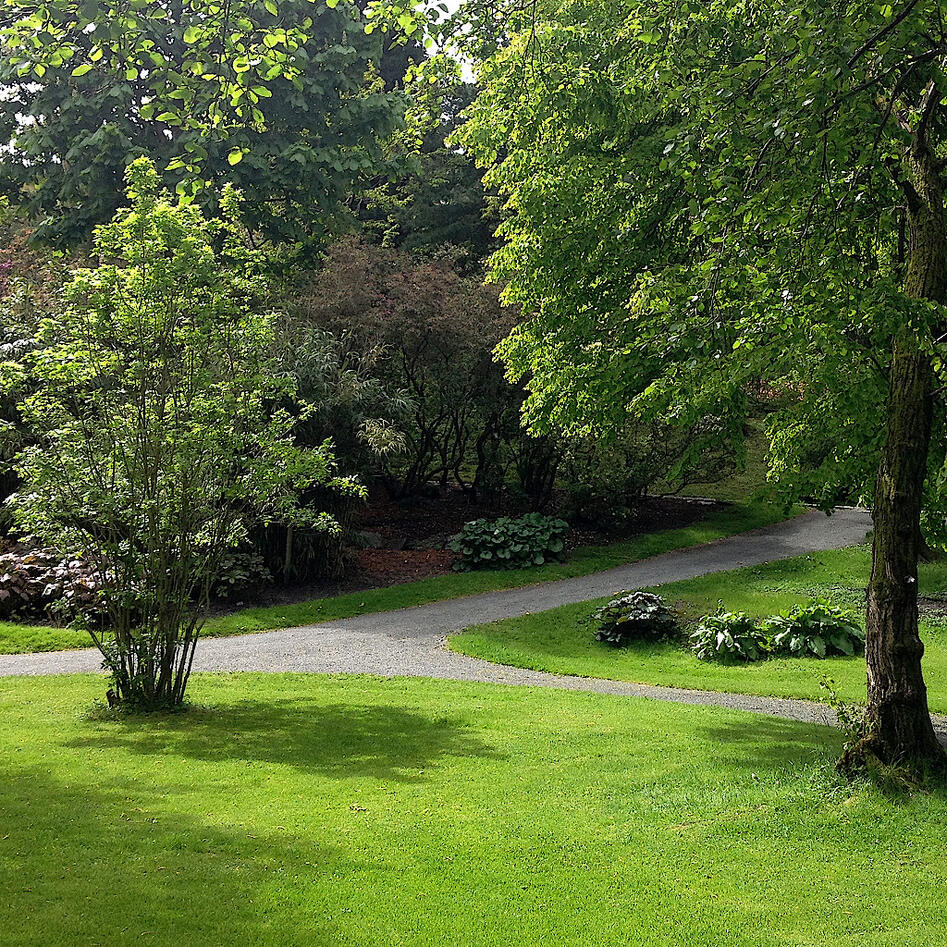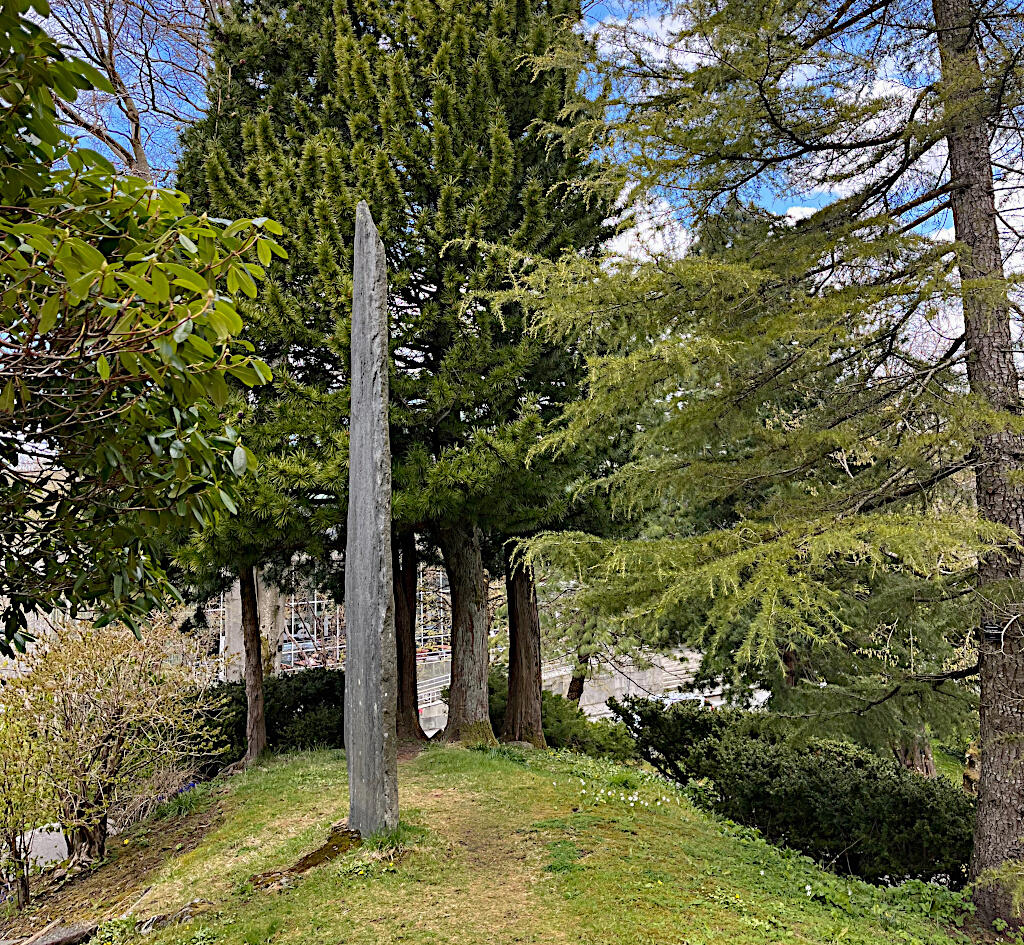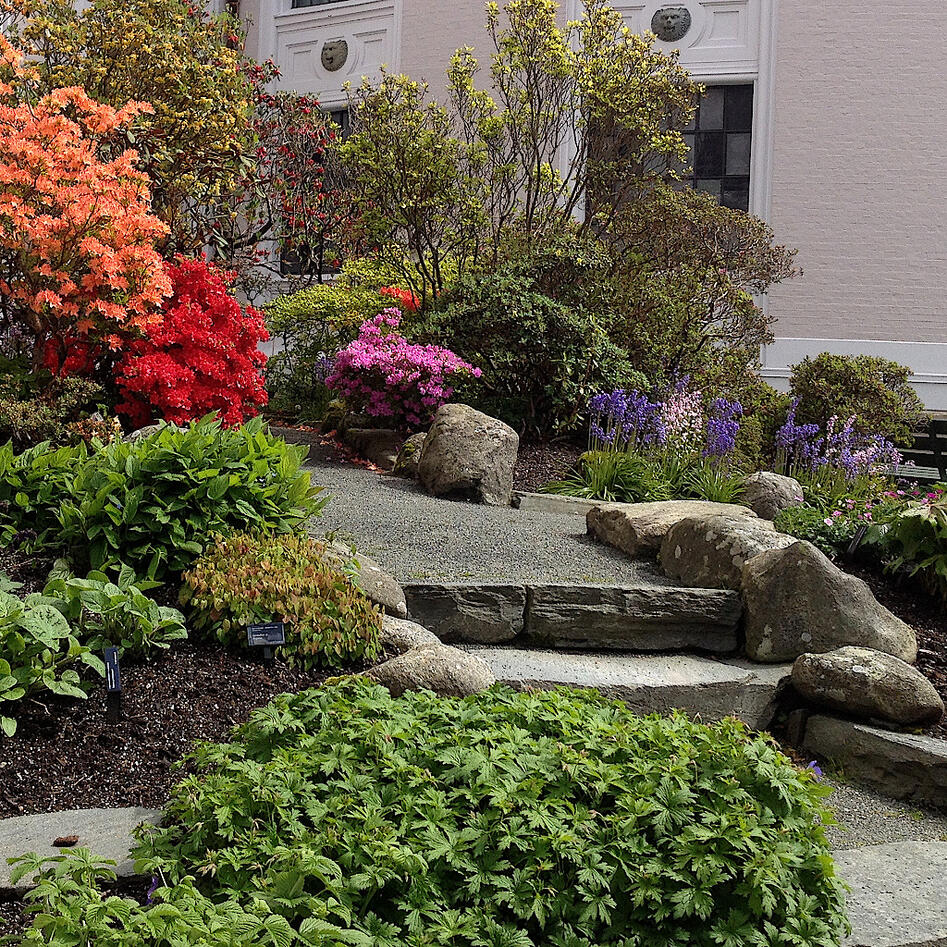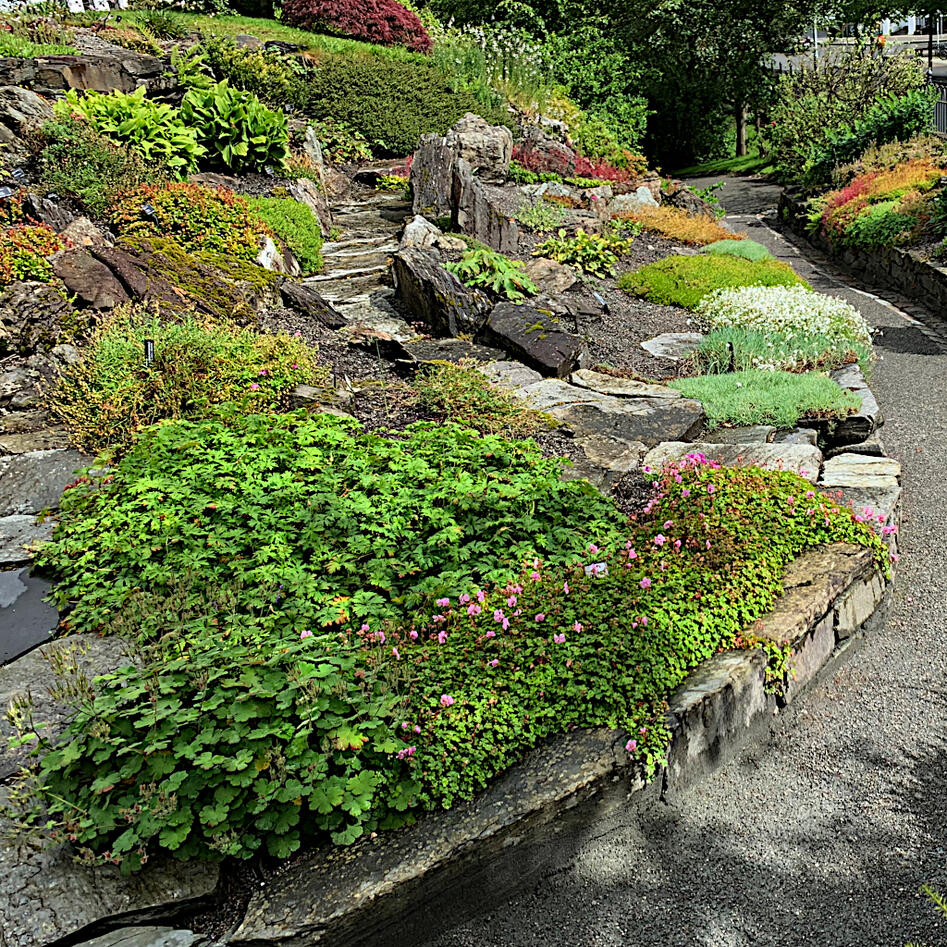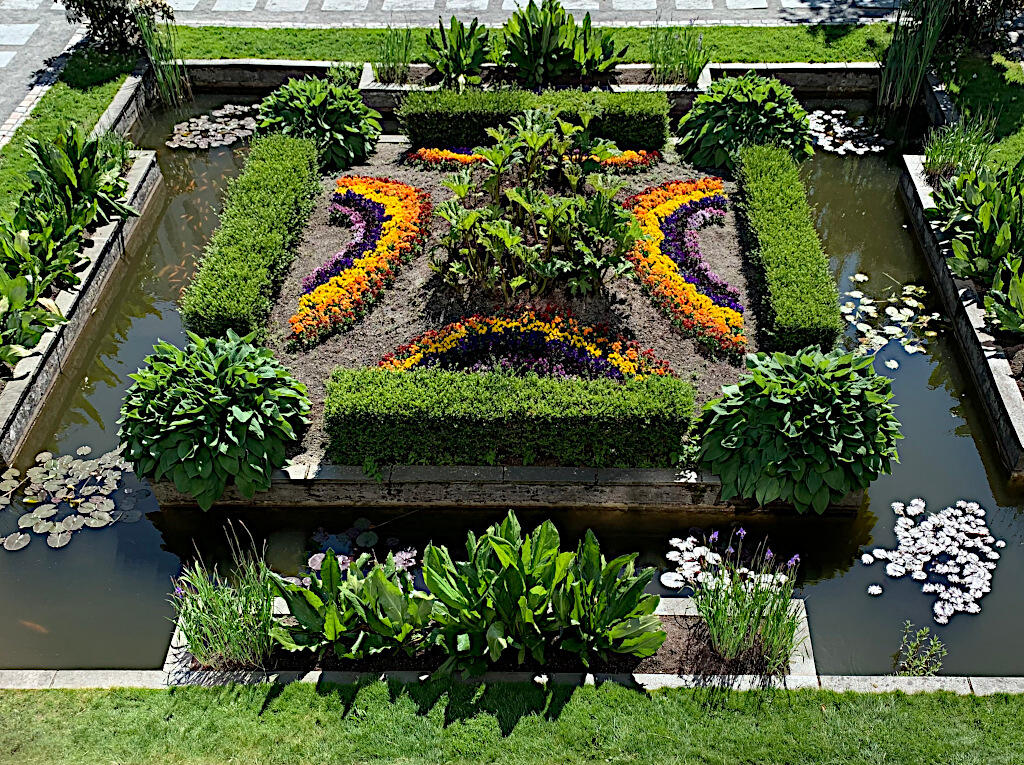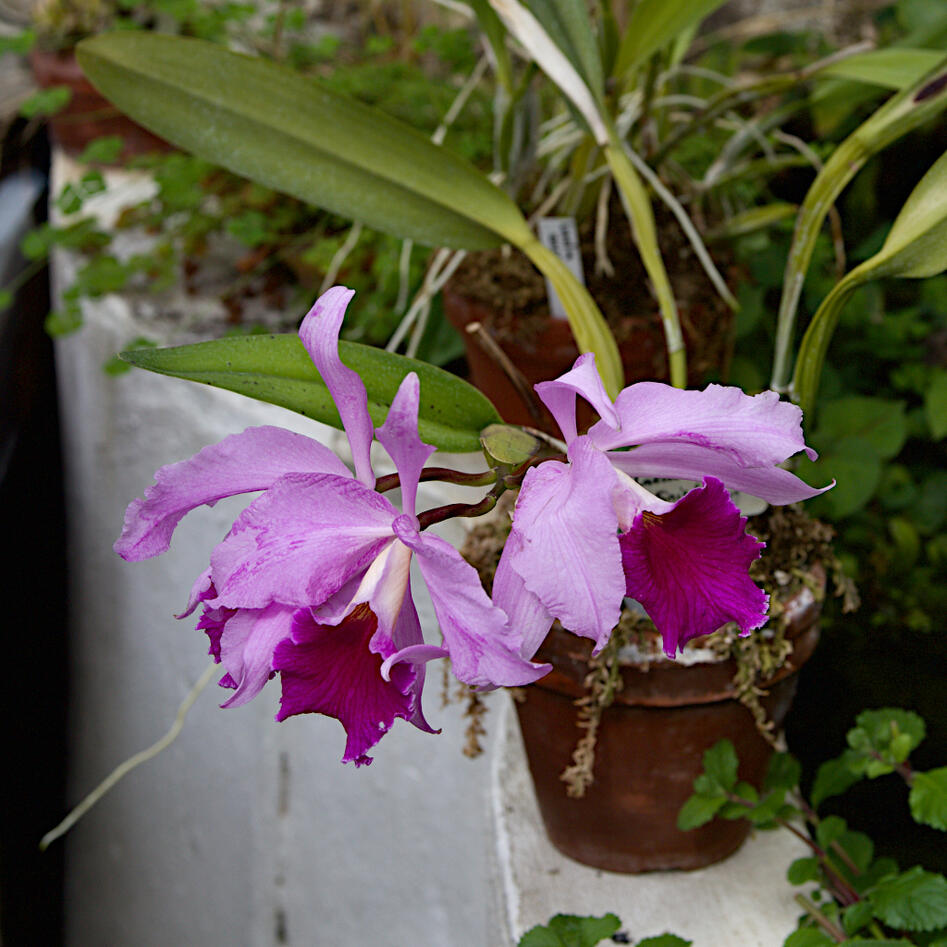This is the Museum Garden
Welcome to the Museum garden! The map shows the different parts of the garden, with brief descriptions below. Symbols on the map indicate some selected plants in the collections, art, and facilities.

Main content
The different parts of the Museum Garden are indicated by capital letters on the map. In addition, green symbols indicate some selected plant highlights. Brown and blue symbols indicate art and facilities, respectively.
A. The Old Garden (Gamlehagen)
The layout of the Old Garden has not changed much since the inauguration of the Museum Garden in 1898, and it has retained its rounded beds and gently curving paths. The systematic part, "systemet" begins here with a collection of conifers, among them Araucaria (monkey puzzle tree), Metasequoia (dawn redwood), Cryptomeria (Japanese cedar), Leyland cypress, and two ancient yew trees. The lawn in the middle of the Old Garden is becoming home to the Magnoliids that includes tulip trees, magnolias, laurel relatives, and some of the earliest flowering plants. On the slope towards the University Museum of Cultural History, the systematic part continues with large bamboos and other representatives of monocot flowering plants.
B. The Chestnut Hill (Kastanjehaugen)
The low rise and the lawn facing the University Museum of Cultural History are planted with trees from the walnut, maple, birch and beech families, which all systematically belong to the large Rosid-group. Most were planted in the mid-1920s. Naturally, there is also a chestnut tree (in the beech family) at the top of the Chestnut Hill. At the top of the rise, next to the bautastone (menhir) from Dale in Fjaler municipality, stands our little umbrella pine grove, along with some other conifers. In the middle of the lawn stands a solitary dawn redwood, and in addition a small collection of roses and other shrubs. Among them some mock-oranges, where Philadelphus pekinensis is noticeable with its pink sepals combined with white flowers and a good fragrance.
C. Useful plants (Nyttevekster)
All life is dependent on plants, but most of us don't think about it. In the garden of useful plants, we show examples of plants that are directly useful to us humans. It was created in 1974 and is framed by a low hedge of mountain currant, and an espalier of modern apple varieties. The various thematic sections have old and newer spices (rosemary, lovage, black cumin etc); other herbs (such as hops, absinth or wormwood, tobacco); food plants, including serveral cererals, buckwheat, onions, cabbage kinds, potatoes etc. There are also fiber plants here that provide useful plant fibers; and plants used for dyeing textiles in green, yellow, red or blue colours.
D. The Rock Garden (Steinbedet)
The particularly favorable conditions in the rock garden are good for heat-loving plants, and those that do not tolerate frost so well. Early spring plants are at the front beds and under the shrubs, and flowering a bit later, the perennial golden nasturtium Tropaeolum polyphyllum from the Andes. The golden nasturtium has flowered here since 1930. Further up, many unusual and sensitive shrubs are planted, such as Olearia xhaastii a natural hybrid from New Zealand, Sarcococca hookeriana an early flowering species in the boxwood family, several rhododendrons, Daphne and a collection of 14 different camellia varieties. The stone bed was completed in 1927 and earlier there was an artificial burial mound here.
E. The Victoria house
The world's largest water lily Victoria is from South America and it has its own house! Its prickly leaves can become up to 3 m in diameter and have a margin that is folded up. The white flower can be 40 cm. The species that we have is from Paraguay. Our small Victoria house also contains a slightly smaller relative, Euryale ferox, the gorgon plant from Asia, with small violet flowers and flat leaves, and a number of other tropical aquatic plants. Previously, a heated pond was built in the 1960s. This was covered every winter until we received a donation in 2019 that made it possible to build a glass house over the pond. The Victoria house has a tropical humid climate all year round and the water temperature is a constant 28°C.
F. The alpine beds (Alpebedet)
The alpine beds contain plants from various high mountain (alpine) environments in the world. Such plants are often low and creeping dwarf shrubs or perennials. Just like they grow in the mountains, we grow the plants on and between the rocks and in crevices. Dwarf shrubs (mountain avens Dryas, willows, Rhododendron, Ruscus and Coprosma, etc.) and low perennials (saxifrages, cinquefoils, houseleeks and Haberlea) grow here, but also a number of taller perennials from mountain meadows. Many spring-flowering bulbs and tubers are also grown here on both sides of the paths. Some plants are tiny, so please walk carefully, crouch and look closely!
G. The water garden (Vannhagen)
The water garden is the garden's main area for ornamental plants. Garden forms (cultivars) of many rhododendrons and other heather plants, various perennials such as alumroot, anemone, hostas, Inca lilies, saxifragas and astilbes are displayed around the three ponds. A large Gunnera with its huge leaves dominates the island in the middle pond. Water lilies and other water plants are grown in the water. Originally, this was a marshy area which was filled in when the garden was developed in the 1890s. Then a lawn and rounded flower beds were laid out with curving paths, but later, the botanist R. Nordhagen wanted aquatic plants in the garden and had the water garden built in 1931. It is very different in form from the original garden plan.
H. The greenhouse (Plantehuset)
The greenhouse at the top of the garden consists of a 10 m tall palm house in the middle, with lower wings on the sides; a tropical humid wing and one with cool climate. The greenhouse has a rich selection of palms, orchids, bananas, papyrus and cocoa trees in the tropical part and more orchids, citrus trees, tree ferns, and cacti and other succulents in the cool part. The greenhouse was purchased as a construction kit from Brzeg in Poland (in what was then Germany) and was a gift from Conrad Mohr, at the time a well known merchant in Bergen. It was inaugurated and opened in 1901. The house has been rebuilt twice. Among other things, the roof of the central palm house has been raised and the original rounded shape changed.
I. The systematic arboretum (Systemet)
When the garden was completed in 1898, a large portion of the plants, particularly trees and shrubs, were placed according to how they were related to each other, based on the current science of the time. Conifers were placed to the north (in the Old Garden) and groups of other seed plants in an arch through the garden, following systematic order. The plants considered to be the most advanced, sympetalous flowering plants, were placed on the other side of the museum, towards Muséplassen. Since then, scientists have produced much data on plant relationships, and we are currently in the process of updating the system so that it reflects current knowledge. This has resulted in a small systematically arranged arboretum in the Museum Garden, and it is marked in dark green on the map.
